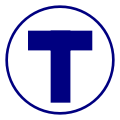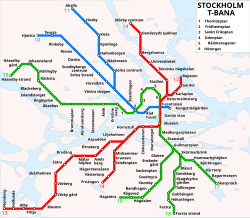The Stockholm Metro (Swedish : Stockholms tunnelbana) is a rapid transit system in Stockholm, the capital city of Sweden. Its first line opened in 1950 as the first metro line in the Nordic countries. Today, the system consists of three lines and 100 stations, of which 47 are underground and 53 above ground. The system is owned by Region Stockholm via SL, the public transport authority for Stockholm County. [3] It is the only metro system in Sweden.
The metro's three coloured lines, Green, Red, and Blue, together form seven routes with different termini. All of these routes pass through the city centre, creating a highly centralised network. The main interchange for all three lines is T-Centralen station, where they intersect. In addition to T-Centralen, the system has three other interchange stations: Fridhemsplan, Slussen, and Gamla stan. Various extensions to the system are currently under construction, An extension to the north-west of Blue Line is expected to open in 2027, while extensions to its south are expected to open in 2030. Construction of a new Yellow Line to the west of the city centre is scheduled to start in 2025. [4]
In 2019, the Stockholm metro transported 462 million passengers, equivalent to approximately 1.27 million on a typical weekday. [5] The 105.7-kilometre-long (65.7 mi) metro system has been operated by MTR since 2 November 2009, whose contract expires at the end of 2024. [6] The system is equipped with ticket barriers. SL operates the metro's ticketing system, with ticketing available via the SL app and rechargeable travel cards. Contactless payment is also accepted at the gates. [7] Ticketing can also be purchased at station booths and select local retailers. SL phased out ticket machines on its network in 2022. [8]
The Stockholm metro has been referred to as 'the world's longest art gallery,' featuring decorations at more than 90 of its 100 stations, including sculptures, rock formations, mosaics, paintings, light installations, engravings, and reliefs created by over 150 artists. [9]





![The 1965 Metropolitan Railway Plan for Stockholm [sv] which follows the current route alignments closely Tunnelbaneplan for Stockholm 1965.jpg](http://upload.wikimedia.org/wikipedia/commons/thumb/7/7f/Tunnelbaneplan_f%C3%B6r_Stockholm_1965.jpg/250px-Tunnelbaneplan_f%C3%B6r_Stockholm_1965.jpg)

































